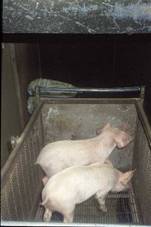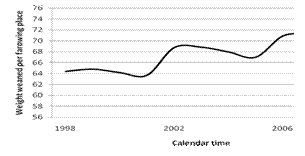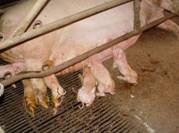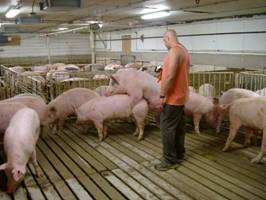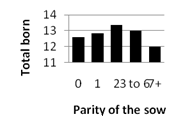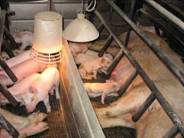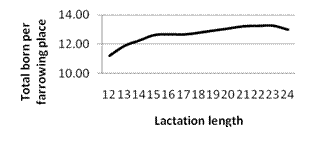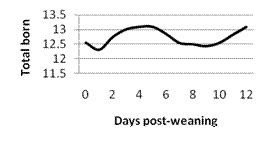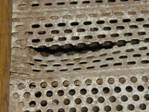Weaning more than 100kg per batch farrowing place
Enhancing the
farrowing area output is about three issues:
1 and 2: The mixture of quality and quantity of
piglet.
3. The quality of the
mother at weaning: in many respects she is more important than the piglets
weaned as she represents future batches.
Defining farrowing room
performance
Pig production
should be about farrowing for profit rather than farming for production
targets. Weaning a 28 day 3 kg pig is
not in the interest of the piglet or the farm.
Euthanasia may be the best option for the runt piglet’s welfare.
If the nursery has
space for 200 pigs (60m2 @ 0.3m2 for pigs to 30kg),
weaning 300 pigs in this batch is not in the interest of the farm or pigs.
|
|
|
|
Farrowing output is quantity |
And quality |
Quantity
In Ireland (for
example) over the last eight years the numbers weaned have increased by nearly
a pig per farrowing place. Other
countries and individual farms have even exceeded these results with 11.5 to 12
weaners per batch farrowing place becoming common.
Change in litter size – total born, born alive and
numbers weaned between 1998 to 2008 in Ireland (Data from the Teagasc National
Pig Herd Performance 2008)

It can be seen that
the increase in numbers of piglets weaned has increased in step with total born
and born alive. The born dead have not
changed significantly over this time.
In North America,
the improvement has started, but is a sudden rise rather than the progressive
increase experienced in Europe. Note the
European pigs are still producing more than 0.5 pigs weaned.
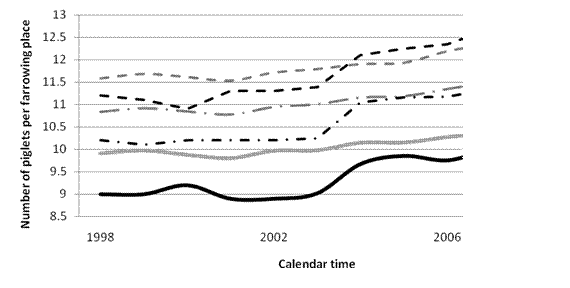
The grey lines are Irish Data (as an example) and the
black line is Canadian.
The upper dotted line is total born, middle dot and
dash line is born alive and the solid line is weaned.
Quality
Over the last eight
years the weight of the piglet weaned has increased, but only by 0.5 kg. In combination with the numbers weaned, this
results in weight weaned per farrowing place.
This has increased, although more chaotic rather than progressive. This area needs to be enhanced.
|
The change in weaning
weight over the years 1998 to 2008 in Ireland (Teagasc 2008) |
The
weight produced at weaning for each batch farrowing place in Ireland 1998 to
2008 (Teagasc 2008) |
|
|
The
most important aspect is the weight weaned per batch farrowing place: a
combination of weight weaned per pig and number weaned per farrowing place: a feature
of both quality and quantity.
The
net effect has been an additional 10 kg weaned per batch farrowing place.
The
Irish records indicate that the average herd size is around 26 sows a week
batch (about 600 sow unit – ((26 sows a week)*(2.3 litters per sow per
year))/(52 weeks). This increase in farrowing production works out at 3406 kg
per week or 177123 kg annual increase in production per farm.
Pre-weaning mortality should be considered zero if
farrowing production targets are met
What is the economic impact of this
improvement and how does this impact your herd
Link to interactive
spreadsheet
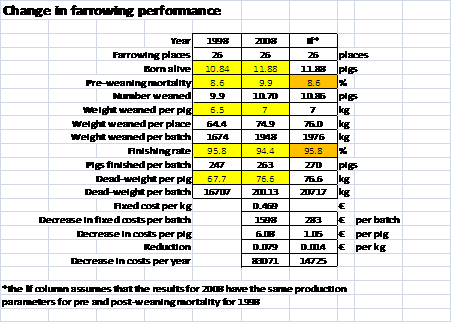
This
records the enormous advantage the improvement in farrowing house performance has
resulted in an €80K improvement in fixed costs over the 10 year period.
In
the table 1, the impact of achieving the same mortality figures from 1998 on
the production figures 2008 indicate that there is a potential for another €14K
cost savings.
When
the data is examined in a little more detail, and the mortality is dissected
into pre-weaning and post-weaning, we find that the potential advantage is
fairly evenly spread between both areas of the farm.
Analysis of table looking at the
breakdown of the potential in mortality improvement
(Note there are some rounding of the numbers below)
|
The
area of improvement |
Per
batch |
Per
year |
|
Pre-weaning
mortality improvement |
€136 |
€7078 |
|
Post-weaning
mortality improvement |
€145 |
€7539 |
|
Pre
and post-weaning mortality improvement |
€283 |
€14725 |
The
improvement of production per farrowing place reduces not only the cost of
production but also the carbon footprint to create the additional pork.
What
factors should be considered when improving the production from the farrowing
house?
The
farm should consider each of the following areas as keys to achieving 100 kg
per batch farrowing place.
Genetics
and preparation of the gilt
Total born rather than born alive
|
|
The major cause of
improvement in numbers weaned has been selection for litter size in gilts and
boars. Selection
pressures should be applied throughout the future gilt’s
life. Weaning is an important
selection point. Gilts should be
removed from the finishing herd at 60 kg and allowed to grow on as a
potential future breeding animal not as a potential finishing animal. A reproduction
check point should be applied at 95 kg when first exposed to the boar. Only those gilts who demonstrate oestrus
within 10 days of boar exposure should be considered for grandparent stock. The larger gilt came from a litter of 8, the
smaller from a litter of 14 – like to change your mind? |
|
Which of these gilts would you pick as your future? |
Reproductive check to enhance litter size and
farrowing rate
|
Boar exposure |
Cycle within 10
days |
Cycle within 24
days |
Cycle after 20
days |
|
Grandparent stock |
Mate on the 3rd
oestrus |
Cull |
|
|
Parent stock |
Mate on the 3rd
oestrus |
Cull |
|
Female:
Ensure gilts are
mated on their third heat, 240 days of age, 130 kg live-weight and 18 mm P2
backfat. The gilt mated should be a
“show gilt”
Mate all return gilts
with a boar and AI. Cull all gilts which
return 2x (or more).
Boar:
If using AI – used
pooled semen. Only for genetic
improvement and boar checking should single dose semen be utilised in
commercial pig production.
Use fresh semen
which is stored at 17⁰C. Thus AI
delivery and storage is paramount.
Mating
environment
A well designed
mating environment is essential to allow for semen transfer from the AI bottle
to the oviduct. This involves setting up
the mating area, well lit, quiet efficient mating and a suitable post-mating
environment. Give them plenty of room –
1.5m2 at least
|
|
|
|
|
Good boar contact |
Specific gilt mating area |
Plenty of light |
Parity total born
|
Parity effect (expected targets)
|
It is essential to
maximize the total born of the gilt. The second litter
size must be at least 0.5 pigs higher than the gilt litter. Then the 3rd litter 1 pig up on
the 2nd litter. A second litter size drop must be avoided. This major reason for a second litter size
drop is the failure of the gilt (now a sow) to eat in her first lactation. |
Minimise pre-weaning mortality
Select away from
diseases
|
|
It has long been
known that pigs which are immune to Escherichia
coli F4 (E. coli K88) can
be produced. Several countries are now
recording gilts and sows whose piglets have diarrhoea and removing these
animals from the breeding pool. All
farrowings house conditions should be noted and decisions made on the impact
of these conditions on the suitability of the mother to be part of the
genetic pool of the future. |
|
Do not select from sows which produce poor health piglets including
piglets with diarrhoea |
Utilise genetic markers
As
specific reproductive genomes become more documented, gene markers will become
more significant in litter size and other characteristics. Currently, the oestrogen receptor (ESR) which
influences litter size and EPOR which influences uterine capacity and litter
size are commercially available.
Breeding routines
The major cause of
piglets not being weaned is an empty farrowing place. Each empty batch farrowing place equates to
880 kg pork. (11 weaned 80kg dead-weight per pig). Pre-weaning mortality starts in the service
area, ensuring the number served is sufficient for the current farrowing rate
and to enhance litter size. Breeding routines are the only way to attempt to
achieve a reasonable standard of hygiene by achieving all-in all-out.
All-in all-out and basic hygiene
To reduce
pre-weaning mortality hygiene must be good.
On a lot of farms all-in all-out is believed to be practiced, but with
poor pig flow, fostering and foster sows this is rarely achieved. The all-in all-out must also be complete,
i.e. do not forget the water supplies. You cannot pressure-wash while sows and
piglets are in the room. Moving piglets
is moving disease.
|
|
|
|
|
Different age groups in the same farrowing area |
Trying to clean with pigs in the room! |
Lime washing helps disinfect and provides a visual guide to the areas
cleaned |
Lime washing
Lime washing the
farrowing area is an excellent way of ensuring that the farrowing area is
cleaned and dry before sows are allowed to enter the farrowing area again.
Sow preparation
Nutrition of the gestating sow
Feeding the
gestating sow
Maintain the body
condition of the sow at 3-3.5. Overweight/fat sows do not eat properly during
lactation. The farrowing house manager
should set the gestation sow feeding curve.
Resolve body condition within the first 60 days of gestation.
|
|
|
|
|
Over weight gilts lead to big over weight sows |
Over weight sows do not eat in lactation |
Thin sows should always be treated as an emergency welfare issue |
Enhance birth weight
by increase feeding from day 90. An
extra 200 g at birth is worth about 6 days to slaughter.
Eliminate udder
oedema and mastitis. Reduce feed intake
from day 110 (point of entry into the farrowing house) and provide 500g of bran
from day 111 to reduce constipation. It is
essential for sows to be hungry for food after farrowing. At the point of farrowing the gilt should
look “plain”. If she is a “show gilt”
she will not eat well in lactation.
Impact of
excellent lactation feed intake
|
|
|
|
Fig 5. Lactation length on total born (expected) |
Fig 6. Wean to service interval on total born
(expected) |
·
Lactation length
effect
When looking at all
sows and gilts, total litter size is significantly reduced if lactation less
than 15 days of length. However, there
are also some subtle parity effects:
Gilts: a lactation length below 19 days the
subsequent production is reduced.
2nd
parity sows: a lactation length below 17 days of age production in 3rd
parity reduced.
·
Wean to service
interval
The wean to service
interval has a tremendous effect on subsequent total born. The sweet point is between 3 and 6 days
post-weaning. During this time, the
farrowing rate is also maximized. The major
factor that influences wean to service interval is lactation feed intake.
Minimise born dead
Stress
Abortions can occur
associated with chilling, fighting or other reasons which may increase the body
core temperature of the pregnant sow.
Abortions reduce the litter size per batch farrowing place and thus the
weight weaned per batch.
Enhance immunity
To the specific
pathogens, listed below. The primary
method of enhanced immunity is through feedback programmes primarily to gilts
during their isolation and acclimatization programmes.
Note homebred gilts
must be treated as purchased gilts. Too
many homebred gilts are poorly acclimatized and inadequately prepared for the
breeding pool.
Specific
pathogens
Aujeszky’s
Disease (Pseudorabies), PRRSv, Parvovirus, Enterovirus, PCV2, and other
SMEDI viruses which may not yet be recognised.
Where relevant Swine Influenza
and Erysipelas
can both reduce litter size.
Mycotoxins
Ensure that the feed
supply is clean. Mycotoxins can reduce,
farrowing rate, litter size and may increase the mummification rate.
Getting the sow to eat
(milk)
Settling sows and
gilts
Ensure sows and
gilts have a couple of days to settle into the farrowing area. Play a radio to help sows and particularly
gilts to settle and avoid savaging issues.
Nutrition of the
lactating sow
Few producers are
able to maximise the sow's potential for milk production, resulting in under nourished
piglets. Feeding of the lactating sow
is a critical job of the farrowing stockperson.
Lysine concentrations have a direct influence on weaning weight, the
recommendation is 1.3% lysine, note also valine (1.3% recommended). Barley based diets may help sows milk better
with fewer problems post-farrowing
Lactation feed
intake is reduced by inadequate water supplies, overweight sows and heat
stress. Thus to enhance lactation feed
intake, copious supplies of water are critical.
Lactating sows on day 18 of lactation, eating 10 kg or more a day with
piglets growing at 400g per day – have been recorded to use 60-100 litres of
water per day! Monitor gestation
condition score. Run farrowing houses
cool. Air temperatures for the sows
should be 20⁰C at farrow, 18⁰C end of the first week and then 16⁰C
until weaning. As summer time
temperatures increase, particularly in Europe, supplemental cooling is going to
be required. Consider drip cooling for
individuals and evaporative cooling for the whole house when the air
temperature exceeds 24⁰C. However,
ensure that the room’s cooling system does not cannot create a draught at
piglet level. A draught to a piglet can
be considered as any air movement greater than 0.1 m/s.
|
|
|
|
|
Adequate water – can you easily check the water 2x a day? |
Add water to the feed trough – here the sow is provided liquid feed –
3:1 water 6x a day. |
Ensure drinkers are accessible – can you spot the drinker – the sow could
see it, but could not use it! Weaning
weights were not good. |
|
|
|
|
|
Cooling systems – Drip. But they must work soon enough – after 24C
and must work. This drip cooler run
constantly causing wet uncomfortable sow and damp piglets |
Air – these have become more popular over the last couple of years. |
Evaporative But the system has to work, the above photograph shows that there are
holes in the system and that the water distribution is not even |
Use an agreed feeding
curve and use known quality of feed per day.
Time of day
feeding sow
Avoid the feeding of
sows when the ambient temperature is too hot i.e. mid-day feeding as this will
reduce total intake. Note feed
presentation; liquid feed can enhance feed intake and weaning weight. Feeding 3x a day may increase feed intake,
but it is unadvised if it increases piglet mortality and reduces batch weaning
weight.
Avoid anything
which may reduce sow lactation feed intake
In particular avoid
vaccination of lactating sows.
Sometimes, vaccines will create a reaction and this can reduce a sow’s
enthusiasm to eat.
Growth rate of
piglets
To ensure good
growth rates in the piglets, adequate milk production is needed for each day of
life. Aim for a consumption of lactation
sow feed (14MJ DE/kg, 18% protein and 1.1% lysine) of around 10 kg by day 18 of
lactation (gilts may only achieve 9kg).
Ensure that the
gilt and sow suckle more than 7 pigs
It is imperative the
gilts and sows are given sufficient number of piglets to encourage milk flow
and thus feed intake. A failure of milk
flow, results in lactation oestrus. Also
note that the failure of milk flow in one lactation adversely affects the subsequent
milk production.
|
|
|
|
|
Feed carefully following a pre-determined feed curve. Ideally feed automatically to reduce stress
on the sow and stockperson |
Avoid vaccinations in the farrowing area – they may interfere with
lactation feed intakes |
Avoid small litters The piglets might be strong, but mum’s feed intake is down,
increasing wean to service intervals |
Gilt management
Provide the gilts
with the stronger piglets, especially within the first 5 days post-farrowing.
Note in outdoor
situations sows may not eat for the first 2 days post-farrowing. Then they will increase their feed intake
sometimes in excess of 14 kg per day after day 18. The combination of excellent water, exercise
and temperature control means these sows have enormous udders and produce piglets
weighing in excess of 12 kg by 28 days of age.
Prepare the farrowing
accommodation
As discussed
previously, this is a feature of breeding protocols and pig flow. Adopt a batch farrowing mentality. It is
essential that the rooms are cleaned and dried before the next batch of sows
enters the farrowing area. Piglets have
two major options with protein intake, lay down lean tissue or produce
antibodies. Hygiene is not just about
set up, but also note cleaning while the piglets are in the room, i.e. prompt
removal of diarrhoea. Have different
coloured brushes and scrapes for each room to reduce any spread of pathogens
between batches.
Adequate farrowing routines
These are necessary to
reduce the number of stillborn piglets and to provide care in the first
critical 24 hours.
Farrowing accommodation design
Chilling is the
number one reason for piglet loss.
Farrowing houses must not have any draughts. There are two micro-environments necessary,
the sow at 16-18⁰C and the piglet at 30⁰C. The farrowing place has got to be able to
accommodate the modern sow. Overfeeding
in gestation results in very large sows which struggle in some farrowing
places.
Adequate set up of farrowing accommodation
The farrowing
accommodation must be very clean. It is
essential to reduce as much as possible the disease risk. The farrowing area must also be set up to
provide heat and a drying environment to the new born piglet. The farrowing area must be draught free. A heat source should be placed behind the
back of the sow, as the piglets are born, to reduce chilling. The provision made at the point of farrowing
is poor on many farms. Piglets should be born into an environment at 30⁰C
which is clean and ideally dry. On
several farms, extending the birthing area into the rear walk passageway helps
to provide this micro-environment. Paper
feedbags can be used as disposable surface for the piglets to be born
upon. The surface the piglets are born
on is a big determinant in creating splayleg piglets.
Colostrum – piglet
immunity
The piglet is born
with no protection. Providing sufficient
protection starts with an effective gilt and sow immunisation programme
(feedback and vaccination). Ensure that
the piglets maximize their colostrum intake.
Draughts and chilling are killers. A chilled piglet only consumes 50% of
the colostrum available and then the stress of chilling reduces antibody uptake
from the stomach by an additional 50%.
Note colostrum intake must occur within 6 hours of birth. Maximising colostrum intake is even more
important in large litters.
There is a
significant difference between the productivity of piglets produced by gilts
and sows.
Gilt piglets will
have lower birth weights, (1.4 vs 1.6); higher post-weaning mortality (9 vs 5%)
and reduced growth rate (600 vs 650g/day).
If gilts are
transferred to sows these effects are minimized – indicating that immunity is a
key reason for these different parity impacts.
The gilt and sow
pass on their “experiences” of their world to their newborn piglet through
colostrum. With modern pig farming,
all-in/all-out and batch systems, it is easy to create extremely naïve mothers
with little “experience” of the world of pathogens. Therefore, their colostrum is insufficient to
protect their offspring. Gilts litters
are particularly susceptible because the last time their mother (the gilt) was
in the farrowing area her own immune system was immature and covered by her
mother’s colostrum. In commercial pig
production we rely on purchased vaccines to supplement the gilt and sow’s
immune system – primarily towards Escherichia coli (E. coli) and
perhaps some Clostridium
perfringens type C. However, there are a wide range of bacteria
and viruses which are associated with pre-weaning diseases which are not
covered by vaccination – Congenital
tremor II (cause as yet unknown), other E. coli types and Clostridia,
Rotovirus,
Streptococcus
and Staphylococcus
to mention only a couple. Alternative
measures need to be adopted to ensure the gilt and sow can provide protection
to these organisms. The easiest method
of providing this protection is by exposing the gilt and sow to these organisms
prior to giving birth to their piglets.
The source of these organisms, which is easy to obtain, is weaner
faeces. Weaners (10 days weaned) are
under the most stress and are excreting many of these “pathogens”, which they
acquired in the farrowing area. If their
faeces are collected and moved to the gilt pens (ideally before the gilt is
bred to the boar), the gilt’s natural curiosity will exposure her to the
organisms within the weaner faeces. Her
immune system will then create antibodies which will eventually be passed onto
her offspring via her colostrum. Several
producers also enhance the adult sow’s immunity by re-exposing the sow to
weaner faeces 6 week pre-farrowing.
However, whenever
moving pig material back around the farm, the all-in/all-out batch concepts of
pathogen movement must also apply. The
feedback programme adopted by the farm must be well constructed and discussed
by the members of the farm health team before being implemented.
Enhancing litter weight at weaning – get piglets to
eat, sleep and play
Prompt feed
intake
40% of pre-weaning
mortality is associated with malnutrition.
Efficient
cross-fostering routines
Protocols should be
in place to provide efficient cross-fostering shortly after birth and later
during lactation. There also needs to be
provision for the weak piglet at weaning through a streaming programme.
From day 14 of
lactation, similar litters can be combined by removing the central dividing
board or providing “doorways”. While
this does not change litter weaning weights, it does raise post-weaning growth
rates and feed intakes by changing the social behaviour of the groups. Combining litters also makes excellent use of
the space available in the farrowing area.
With heavier and more piglets, the space in the current farrowing place
can become limiting.
|
|
|
|
Combine litters after day 14 |
Perfectly normal in outdoor units |
Maximise piglets' feed intake
Through good access
to teats, providing good mothering sows and ensuring sows provide adequate
milk. Ensure that the farrowing crate
does not cause physical obstruction to the udder. Poorly designed bars can interfere with teat
access. Piglets are very teat specific,
check sows with teats which have failed for physical obstructions. Liquid
(milk) feed from farrowing may enhance gut development. In large litters provision of milk can
enhance numbers weaned (halved pre-weaning mortality, enhanced litter size by
0.7 piglet and 1 kg enhanced farrowing place weaning weight). But note this must not reduce sow feed
intake.
Palatable creep feed
is needed from day 14 to improve weaning weights. Feed creep three times a day. Use good quality creep. Use a creep tray (which is sterilised
between batches and litters). Keep creep
feed cool. Store creep in the cool and dry off the ground. Again, creep feed is not to reduce lactation
feed intakes. It is cheaper to get the
sow to look after her piglets.
Peat and soil may be
provided. These products reduce
pre-weaning diarrhoea. However, ensure
that the peat and soil are pasteurised to reduce mycobacterium and rhodococcus
issues.
Efficient and humane piglet processing controls
Clean well
maintained and effective protocols for tail docking, iron injecting,
castrating
and vaccination
should be in place. Poor teeth clipping
is a major cause of joint ill.
Provide piglets with an ideal environment – see causes of
pre-weaning diarrhoea
Water
While difficult to
justify at times, water should be available for suckling piglets. For example,
a nipple drinker should be 10-13 cm from the ground and provide water at 300 ml
per min.
Air
Air speed zero
(Om/s). Even slow air movement, 0.1 m/s,
increases lower critical temperature (LCT) by 6⁰C, thus from 30 to 36⁰C.
Ambient air
temperature needs to be 30⁰C. Note
heat mat infra-red temperatures may be higher at 36-40⁰C. No insulation increase LCT 5⁰C. Wet floor increases LCT 10⁰C. Forcing piglets to sleep in diarrhoea covered
heat mats is not good practice.
Outdoors check
farrowing arc has no holes. Earth farrowing arcs to prevent draughts. Maintain straw depth and management.
Feed – as discussed.
Floor
Insulated solid
areas are required. Ensure slatted areas
are not rough. Control flies, birds and
other rodents. In outdoor situations control
foxes, seagulls, magpies and other hunting birds outdoors. Ensure fenders fit
well onto farrowing arc and ensure no piglet under 10 days of age is able to
escape.
|
|
|
|
|
|
Water The poor position of the piglet drinker contributed to high
pre-weaning mortalities |
Feed Creep feed should only be feed out of a creep tray. Feed little and often. The creep tray is not be become a toilet |
Floor Damaged floor resulted in a piglet losing a foot. Weight sold per batch farrowing place down 80 kg! |
Air Multiple errors above. The heat lamps are misplaced and the floor mats are not evenly
distributed between the creep areas |
Reduce disease levels
Good recognition of
the pathogen causing a problem and prompt treatment. Note not all “diseases” are purely associated
with a pathogen. The farm team needs to
have a willingness to submit live pigs for post-mortem investigations – these
are acutely ill and most likely to allow accurate diagnosis.
Adequate feed-back
and vaccine programmes are essential.
Congenital
tremor AII, greasy pig
disease and meningitis
in piglets in the farrowing area are all directly associated with poor gilt and
sow immunisation programme.
Storage programmes
of piglet medicines need to be adequate.
Take care moving medicines, needles and syringes between batches of
pigs.
Manually remove the
faeces from the sow 3 days pre and 3 days post-farrowing.
Adopt an active
anticoccidosis programme.
Is the post-weaning
accommodation suitable for the weight of the pigs moving into the
accommodation?
Reducing weaning age
may increase litters per sow per year. But saving on
farrowing room can be false economy when the cost of nursery space and the feed
required to feed the piglet for an extra week (or more).
Summary
Adopt a batch
mentality and measure success of farrowing production based on weight of
piglets being weaned every batch throughout the whole year.
Checklist for the farrowing
area
|
Key |
Question |
Answer |
Indicates |
|
1 |
What is the level of diarrhoea in piglets? |
None |
Draughts, chilling, colostrum
management |
|
2 |
How much food is eaten on day 18 by the sow? |
>10 kg per day |
Water availability,
feeding policies – lactation and gestation and temperature management |
|
3 |
Number and weight of weaned piglets per batch? |
> 90 kg per place |
Pig flow, diseases issues
in lactation, lactation feed intake, breeding management. |
A CHECKLIST FOR THE
FARROWING AREA-INDOORS
|
|
Comments |
|
|
Genetics |
Does the farm select their own gilts? |
|
|
At what age/weight are the gilts selected? |
|
|
|
What are the specific criteria
selected? |
|
|
|
Pig
Flow |
Number of farrowing places per batch? |
|
|
Biosecurity |
All-in all-out procedures – check
breeding pattern |
|
|
Use of footbaths |
|
|
|
Building maintenance |
|
|
|
Stock |
Empty farrowing places? |
|
|
Sows’ body condition at entry |
|
|
|
Sow condition at weaning |
|
|
|
Are any sows not in pig? |
|
|
|
Late or early farrowings |
|
|
|
Udder oedema, mastitis or metritis |
|
|
|
Quality of piglets at birth |
|
|
|
Sow mortality, prolapses, etc. |
|
|
|
Sow health problems |
|
|
|
Litter sizes, still-births, mummified
piglets |
|
|
|
Congenital conditions |
|
|
|
Diarrhoea levels. Treatments. |
|
|
|
Health of piglets, evenness of growth |
|
|
|
Respiratory disease, rhinitis,
pneumonia |
|
|
|
Parasites, fly control |
|
|
|
Numbers weaned |
|
|
|
Weaning weight |
|
|
|
Water |
Water availability. |
|
|
Food |
Feeding protocols |
|
|
Feeder management – moldy feed |
|
|
|
Overfed sows |
|
|
|
Floor |
Dry floors |
|
|
General Hygiene |
|
|
|
Air |
Room temperature |
|
|
Cooling systems |
|
|
|
Creep/heat mat temperatures |
|
|
|
Evidence of draughts |
|
|
|
Stockmanship |
Farrowing problems |
|
|
Are other procedures being done
properly? |
|
|
|
Are medication procedures being carried
out properly e.g. mange, worming, vaccination? |
|
|

